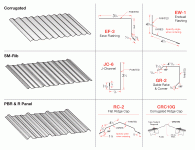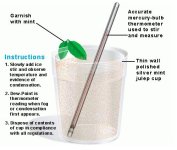s219
Super Member
- Joined
- Dec 7, 2011
- Messages
- 8,608
- Location
- Virginia USA
- Tractor
- Kubota L3200, Deere X380, Kubota RTV-X
I've only put on 3 metal roofs in my life, but learned a lot each time and did a lot of homework before that very first job.
Most common leaks are due to people over-driving the screws so that the screw gasket squishes and bulges out, then it's exposed to the elements and deteriorates much faster. The gasket should just barely plump then you stop screwing down. This way the washer acts as a "hat" to protect the gasket underneath.
The second issue is lack of use of butyl tape at the overlap seams. Seems like it should be common knowledge or a requirement, but many people skip the tape. Many people also fail to orient the overlaps away from the prevailing wind, making that problem even worse! If you orient the overlaps and use tape, those seams should never leak. Tape should also be used where any gable trim screws down over the top of the edge panels.
Finally, ridge lines are often handled wrong. There should be a foam gasket in place to seal the gaps in the corrugation. Butyl tape should go down on top of the gasket, and then the ridge cap screws down over that through the raised part of the corrugations. I like using self tapping metal screws to screw the ridge cap to the panels. If you use longer wood screws to screw the cap through the panels into purlins or sheathing, you get less control over snugging everything together without over-driving the screws, but it's doable.
So in this case, I'd climb up on the roof and take a look at the screws/washers/gaskets, the panel seams (look for tape or lack of it by trying to slide an index card through), and then eyeball the ridge cap and seals.
Issues at the ridge will tend to leak right at the ridge in most cases. Seam leaks and screw leaks can appear to be widespread or present drips in places away from the actual leak. In general, leaks are a pain to diagnose, but try to keep looking for the farthest "uphill" place where you see the water and start from there with diagnosis/repair.
Most common leaks are due to people over-driving the screws so that the screw gasket squishes and bulges out, then it's exposed to the elements and deteriorates much faster. The gasket should just barely plump then you stop screwing down. This way the washer acts as a "hat" to protect the gasket underneath.
The second issue is lack of use of butyl tape at the overlap seams. Seems like it should be common knowledge or a requirement, but many people skip the tape. Many people also fail to orient the overlaps away from the prevailing wind, making that problem even worse! If you orient the overlaps and use tape, those seams should never leak. Tape should also be used where any gable trim screws down over the top of the edge panels.
Finally, ridge lines are often handled wrong. There should be a foam gasket in place to seal the gaps in the corrugation. Butyl tape should go down on top of the gasket, and then the ridge cap screws down over that through the raised part of the corrugations. I like using self tapping metal screws to screw the ridge cap to the panels. If you use longer wood screws to screw the cap through the panels into purlins or sheathing, you get less control over snugging everything together without over-driving the screws, but it's doable.
So in this case, I'd climb up on the roof and take a look at the screws/washers/gaskets, the panel seams (look for tape or lack of it by trying to slide an index card through), and then eyeball the ridge cap and seals.
Issues at the ridge will tend to leak right at the ridge in most cases. Seam leaks and screw leaks can appear to be widespread or present drips in places away from the actual leak. In general, leaks are a pain to diagnose, but try to keep looking for the farthest "uphill" place where you see the water and start from there with diagnosis/repair.

